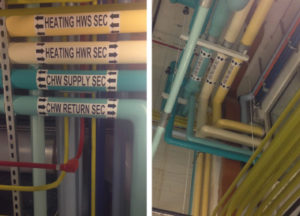Energy Innovation Center
 The Energy Innovation Center (EIC) is designed to provide a site for environmentally-conscious organizations to collaborate and a physical center for the region’s green economy. The EIC encourages product and business development, as well as structured education and training programs focused on sustainable technologies and systems. Developed in collaboration with the Pittsburgh Gateways Corporation, research universities, economic development organizations, and the Department of Energy’s National Energy Technology Laboratory, the EIC provides a broad array of energy sector workforce development services. The main programs within the EIC include co-located university-industry projects, proof-of-concept energy technology demonstration laboratories, early-stage business incubation, and workforce training.
The Energy Innovation Center (EIC) is designed to provide a site for environmentally-conscious organizations to collaborate and a physical center for the region’s green economy. The EIC encourages product and business development, as well as structured education and training programs focused on sustainable technologies and systems. Developed in collaboration with the Pittsburgh Gateways Corporation, research universities, economic development organizations, and the Department of Energy’s National Energy Technology Laboratory, the EIC provides a broad array of energy sector workforce development services. The main programs within the EIC include co-located university-industry projects, proof-of-concept energy technology demonstration laboratories, early-stage business incubation, and workforce training.
The project is located in the 200,000 SF Clifford B. Connelley Trade School, a national historic landmark, which opened in 1930 in Pittsburgh’s Hill District. The project is unique in that it achieves high levels of distinction for both historic preservation and energy and environmental performance. All renovations are historically sensitive and meet the strict requirements of landmark alteration review.
evolveEA helped ensure that preservation standards could be reconciled with ambitious sustainability goals. We guided the design and construction team to achieve LEED Platinum certification, incorporating an impressive array of sustainable design features and innovative building technologies.
Sustainable Design Features
The site design minimizes storm water runoff, uses of native/adaptive plantings, eliminates landscape irrigation and reduces the environmental impacts of paving. Highly efficient energy and water systems, as well as comfortable and healthy interior environments were built using sustainable materials and systems leveraged to contribute to the local economy and provide expanded workforce opportunities, education and training.

Wiring and pipes throughout the building are color coded and labeled to demonstrate to occupants and visitors how the building systems operate. This also makes building maintenance more efficient by eliminating guess work for maintenance workers.
Energy efficient aspects of the project include natural light and day lighting controls, insulation of the existing building envelope, replacement of existing curtain wall window systems, a super-critical carbon dioxide-based geothermal ground source heat pump system, active chilled beams and radiant panels, Dedicated Outdoor Air Systems (DOAS) with MERV-13 filters, passive desiccant wheels for moisture control, energy recovery and Demand Controlled Ventilation (DCV). The building systems were also designed to demonstrate demand side energy management control strategies through the use of ice storage, and the future implementation of a Combined Heat and Power (CHP) system with an absorption chiller that utilizes waste heat from the CHP plant.
Tenants are provided with advanced thermal comfort through dehumidified outdoor air and local sensible cooling. This approach saves energy by providing lower space relative humidity levels and warmer space temperatures to achieve the same level of comfort. Tenants also have the opportunity to utilize numerous sensible cooling technologies within their space such as chilled beams, radiant cooling panels, or conventional fan coils and/or terminal heat pumps. Part of evolveEA’s scope for the project included developing tenant guidelines to make sure that building occupants contribute to the building’s efficiency.
Green Building Education Plan
evolveEA developed a suite of education materials for tenants, staff and visitors to explain the building’s systems and the unique aspects of its sustainable design and historic preservation. One of the pieces is the slideshow shown below.


